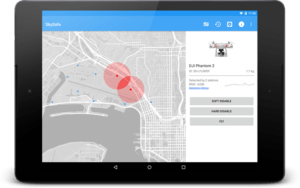
According to TechCrunch, SkySafe, a new California-based startup, recently attracted $3 million in seed funding from Andreessen Horowitz, Founder Collective, SV Angel, and BoxGroup. The firm has developed a radio-wave transmission device that can allegedly cut the signal between a drone and its remote, allowing a SkySafe user to bring it down.
The company is tight-lipped about the details of its new tech; however, SkySafe CEO Grant Jordan told TechCrunch that the technology is relatively “unique in that it’s about mitigation, not just detection. We take complete control of the drone. It sees us as the legitimate controller.” A SkySafe user can detect drones using a smartphone-based app and then use a black-box device to either take control of the drone or cut its power.
Jordan told TechCrunch:
We’re basically building a perimeter [with nodes] and monitoring facilities for activity. So we monitor airwaves for signals that drones use — identifying them by their signature so we know which are whitelisted and which aren’t — then we can alert [our customer] when drones are detected that aren’t supposed to there so that the operator can take action to safely take over the drone.
The anti-drone industry is sprouting a growing diversity of new solutions – from an “anti-drone rifle” by Batelle Innovations to the Orwellian-sounding “anti-drone death ray” from Anti–AUV Defense System.
And, who can forget Dutch company, Guard From Above, after the firm announced a partnership with the nation’s federal police force to deploy eagles and other raptors to identify and take down drones (despite cries of “fowl play” by wildlife experts).
Other examples include, DroneShield, which uses acoustic technology to detect incoming drones from up to 150 yards and sends emails or text messages to a monitoring service.
According to a study by India-based business-intelligence firm MarketsandMarkets, the anti-drone market is expected to grow to a billion-dollar industry within six years with predicted compound annual growth rate of 23.89 percent across 2017-22.
Jason is a longstanding contributor to DroneLife with an avid interest in all things tech. He focuses on anti-drone technologies and the public safety sector; police, fire, and search and rescue.
Beginning his career as a journalist in 1996, Jason has since written and edited thousands of engaging news articles, blog posts, press releases and online content.
Email Jason
TWITTER:@JasonPReagan
Subscribe to DroneLife here.